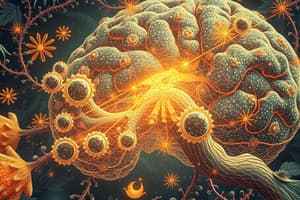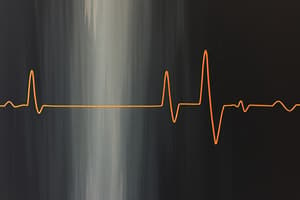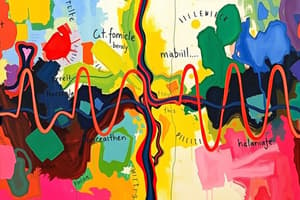Podcast
Questions and Answers
What organism was primarily utilized by Hodgkin and Huxley in their Nobel Prize-winning action potential experiments?
What organism was primarily utilized by Hodgkin and Huxley in their Nobel Prize-winning action potential experiments?
- Human neuron
- Mouse neuron
- Frog muscle fiber
- Squid giant axon (correct)
What was the primary technique employed by Hodgkin and Huxley to measure the action potential in the squid giant axon?
What was the primary technique employed by Hodgkin and Huxley to measure the action potential in the squid giant axon?
- Voltage-clamp technique (correct)
- Patch-clamp recording
- Immunofluorescence microscopy
- Electron microscopy
Before stimulation, what electrical characteristic did Hodgkin and Huxley observe in the squid giant axon?
Before stimulation, what electrical characteristic did Hodgkin and Huxley observe in the squid giant axon?
- Negative membrane potential (correct)
- Positive membrane potential
- Neutral membrane potential
- Fluctuating membrane potential
What type of stimulus is required to initiate an action potential in the squid giant axon, according to the text?
What type of stimulus is required to initiate an action potential in the squid giant axon, according to the text?
Which of the following is a characteristic of the action potential waveform, as described in the content?
Which of the following is a characteristic of the action potential waveform, as described in the content?
How does altering the extracellular potassium concentration ([K+]OUT) affect the membrane potential (VM), based on the experiments described?
How does altering the extracellular potassium concentration ([K+]OUT) affect the membrane potential (VM), based on the experiments described?
What is the effect of altering the extracellular sodium concentration ([Na+]OUT) on the resting membrane potential?
What is the effect of altering the extracellular sodium concentration ([Na+]OUT) on the resting membrane potential?
What was Hodgkin and Huxley's 'sodium hypothesis' regarding the rising phase of the action potential?
What was Hodgkin and Huxley's 'sodium hypothesis' regarding the rising phase of the action potential?
What is the primary trigger for the opening of the M gate in a nerve cell membrane?
What is the primary trigger for the opening of the M gate in a nerve cell membrane?
Which gate is responsible for the active repolarization phase by decreasing sodium conductance?
Which gate is responsible for the active repolarization phase by decreasing sodium conductance?
Which ion channel is associated with the N gate?
Which ion channel is associated with the N gate?
Which segment is identified as the voltage sensor in ion channels like Na, K, and Ca channels?
Which segment is identified as the voltage sensor in ion channels like Na, K, and Ca channels?
What is the primary function of the 'm' gate in the sodium channel?
What is the primary function of the 'm' gate in the sodium channel?
What prevents Sodium (Na+) and Potassium (K+) ions from canceling each other out during an action potential?
What prevents Sodium (Na+) and Potassium (K+) ions from canceling each other out during an action potential?
Which structural element constitutes the pore region in ion channels?
Which structural element constitutes the pore region in ion channels?
What technique is employed to measure currents flowing through individual ion channels?
What technique is employed to measure currents flowing through individual ion channels?
What structures fold into the ion channel pore and contribute to ion selectivity?
What structures fold into the ion channel pore and contribute to ion selectivity?
Which segment acts as the voltage sensor in ion channels?
Which segment acts as the voltage sensor in ion channels?
What is the role of the inactivation particle in an ion channel?
What is the role of the inactivation particle in an ion channel?
Which charges stabilize the S4 segment in its resting state?
Which charges stabilize the S4 segment in its resting state?
What ion is shown passing through the ion channel in the provided diagram?
What ion is shown passing through the ion channel in the provided diagram?
What does the length constant (λ) represent in electrotonic membrane properties?
What does the length constant (λ) represent in electrotonic membrane properties?
What does the time constant (τ) represent in electrotonic membrane properties?
What does the time constant (τ) represent in electrotonic membrane properties?
Which of the following is crucial for action potential propagation?
Which of the following is crucial for action potential propagation?
What is the primary purpose of action potentials in neurons and muscle cells?
What is the primary purpose of action potentials in neurons and muscle cells?
Which of the following best describes "frequency coding" in the context of action potentials?
Which of the following best describes "frequency coding" in the context of action potentials?
What distinguishes electrically excitable neurons from electrically inexcitable neurons?
What distinguishes electrically excitable neurons from electrically inexcitable neurons?
Which ions play a critical role in the generation of action potentials through voltage-gated channels?
Which ions play a critical role in the generation of action potentials through voltage-gated channels?
What occurs during the rising phase of an action potential?
What occurs during the rising phase of an action potential?
What characterizes the absolute refractory period of an action potential?
What characterizes the absolute refractory period of an action potential?
Which equation represents the membrane potential (VM)?
Which equation represents the membrane potential (VM)?
What makes the squid axon a suitable model for studying action potentials?
What makes the squid axon a suitable model for studying action potentials?
What biophysical property limits the frequency of action potentials?
What biophysical property limits the frequency of action potentials?
How does an action potential propagate along an axon?
How does an action potential propagate along an axon?
What is saltatory conduction?
What is saltatory conduction?
How does myelin increase action potential conduction velocity?
How does myelin increase action potential conduction velocity?
Which channels are concentrated at the Nodes of Ranvier?
Which channels are concentrated at the Nodes of Ranvier?
What impact does increasing axonal diameter have on conduction velocity?
What impact does increasing axonal diameter have on conduction velocity?
What role does the length constant (l) play in action potential propagation?
What role does the length constant (l) play in action potential propagation?
What is Multiple Sclerosis?
What is Multiple Sclerosis?
Flashcards
Action Potential (AP)
Action Potential (AP)
A rapid change in membrane potential used for neuronal communication.
Frequency Coding
Frequency Coding
The intensity of an AP's frequency indicates the strength of a stimulus.
Recruitment
Recruitment
The number of axons firing APs determines the amount of information sent.
Place Code
Place Code
Signup and view all the flashcards
Resting Membrane Potential (VM)
Resting Membrane Potential (VM)
Signup and view all the flashcards
Absolute Refractory Period
Absolute Refractory Period
Signup and view all the flashcards
Relative Refractory Period
Relative Refractory Period
Signup and view all the flashcards
Voltage-Gated Channels
Voltage-Gated Channels
Signup and view all the flashcards
Action Potential
Action Potential
Signup and view all the flashcards
Hodgkin and Huxley
Hodgkin and Huxley
Signup and view all the flashcards
Squid Giant Axon
Squid Giant Axon
Signup and view all the flashcards
Voltage-Dependent Gating
Voltage-Dependent Gating
Signup and view all the flashcards
Depolarization
Depolarization
Signup and view all the flashcards
Overshoot of Action Potential
Overshoot of Action Potential
Signup and view all the flashcards
Ionic Basis of Resting Potential
Ionic Basis of Resting Potential
Signup and view all the flashcards
Sodium Hypothesis
Sodium Hypothesis
Signup and view all the flashcards
Voltage-dependent permeability
Voltage-dependent permeability
Signup and view all the flashcards
Gating particles
Gating particles
Signup and view all the flashcards
Hodgkin cycle
Hodgkin cycle
Signup and view all the flashcards
M gate
M gate
Signup and view all the flashcards
H gate
H gate
Signup and view all the flashcards
N gate
N gate
Signup and view all the flashcards
Voltage sensor (S4 segment)
Voltage sensor (S4 segment)
Signup and view all the flashcards
Voltage-Dependent Channels
Voltage-Dependent Channels
Signup and view all the flashcards
Action Potential Conduction Speed
Action Potential Conduction Speed
Signup and view all the flashcards
Saltatory Conduction
Saltatory Conduction
Signup and view all the flashcards
Length Constant (l)
Length Constant (l)
Signup and view all the flashcards
Myelination Effects
Myelination Effects
Signup and view all the flashcards
Node of Ranvier
Node of Ranvier
Signup and view all the flashcards
Electrotonic Properties
Electrotonic Properties
Signup and view all the flashcards
Frequency Limitations of APs
Frequency Limitations of APs
Signup and view all the flashcards
Ion Selectivity Filter
Ion Selectivity Filter
Signup and view all the flashcards
S4 Segment
S4 Segment
Signup and view all the flashcards
S5-S6 Linkers
S5-S6 Linkers
Signup and view all the flashcards
Inactivation Particle
Inactivation Particle
Signup and view all the flashcards
Time Constant (t)
Time Constant (t)
Signup and view all the flashcards
Passive Membrane Properties
Passive Membrane Properties
Signup and view all the flashcards
Study Notes
Action Potential Overview
- Action potentials are crucial for rapid information transport in axons and muscles.
- They are generated by the opening and closing of voltage-gated ion channels, leading to a rapid change in membrane potential.
- Action potentials are all-or-none events, meaning they either occur completely or not at all, once triggered.
Mechanisms of Action Potential
- Frequency coding: The intensity of a signal is represented by the frequency of action potentials.
- Recruitment: The number of axons firing action potentials represents a stronger signal.
- Place code: The identity of the axon carrying the action potential indicates the origin of the signal.
- Voltage-gated Na+, K+, and Ca++ channels generate the action potential's rapid and faithful propagation.
Types of Neurons
- Some neurons utilize graded potentials for short-distance signaling. These graded potentials are passive and do not propagate long distances.
- Example: retinal bipolar neurons
- Most neurons use action potentials (nerve impulses), which regenerate and propagate over long distances. These potentials are electrically excitable.
- Example: lower motor neurons in the spinal cord
Action Potential Phases
- Resting phase: The membrane potential is negative (approximately -70 mV). Specific ion channels are open at this point in time.
- Rising phase: The membrane potential rapidly increases toward a positive value. This is driven by the influx of Na+ ions across the membrane.
- Overshoot: The membrane potential briefly becomes positive.
- Falling phase: The membrane potential rapidly returns to a negative value. This is due to the outward movement of K+ ions.
- Undershoot (after-hyperpolarization): The membrane potential dips below the resting potential before gradually returning.
Action Potential Characteristics
- Threshold: The minimum voltage necessary to initiate an action potential.
- Refractory periods: A period during and after an action potential firing where it's difficult or impossible to fire another action potential. This includes the absolute and relative refractory periods.
Investigating the Action Potential
- Factors affecting membrane potential (VM) - P(ION), E(ION)
- Role of squid giant axon in studying action potentials - Easy preparation of the large axon allowed detailed studies of ion currents during the action potential.
- Hodgkin and Huxley - Proposed the voltage-gated ion channels as the basis for generating and propagating action potentials.
Ionic Basis of Action Potential
- Sodium hypothesis: The change in membrane potential(VM) during an action potential is primarily due to changes in Na+ permeability.
- Voltage-gated Na+ channels open and close rapidly in response to depolarization.
- Voltage-gated K+ channels open and close more slowly than Na+ channels as the membrane potential rises and falls.
- Voltage-dependent ion channel gates-m, h, n states represent the different conformational states of the ion channels.
- Structure and function of ion channels: Pore, voltage sensing module, inactivation particle
Passive and Active Membrane Properties
- Passive decay or electrotonic spread occurs in the absence of voltage-dependent ion channel opening.
- Length constant (λ): distance over which an initial voltage change decays to about 37% of its original value, depending on the resistance along and across the membrane.
- Time constant (τ): time (in milliseconds) it takes for a change in membrane potential to decay to about 37% of its original value.
Action Potential Propagation
- Propagation occurs due to passive spread of depolarization and the opening of voltage-gated channels.
- Myelin significantly increases conduction velocity.
- Saltatory conduction: action potential "jumps" between gaps in the myelin sheath (nodes of Ranvier)
Action Potential Velocity Improvement
- Decrease RA (axon resistance): Larger diameter axons have lower resistance, leading to faster conduction.
- Increase RM (membrane resistance): Myelin sheaths increase membrane resistance, increasing length constant, facilitating saltatory conduction.
Synaptic Summation
- The summation of EPSPs (excitatory postsynaptic potentials) and IPSPs (inhibitory postsynaptic potentials) results in a total postsynaptic potential.
Studying That Suits You
Use AI to generate personalized quizzes and flashcards to suit your learning preferences.




